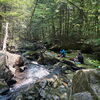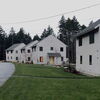
Processing Your Payment
Please do not leave this page until complete. This can take a few moments.
- News
-
Editions
View Digital Editions
Biweekly Issues
- December 1, 2025
- Nov. 17, 2025
- November 03, 2025
- October 20, 2025
- October 6, 2025
- September 22, 2025
- + More
Special Editions
- Lists
- Viewpoints
-
Our Events
Event Info
Award Honorees
- Calendar
- Biz Marketplace
Site for York Co. housing development tweaked to accommodate endangered turtle
 Courtesy / Terradyn Consultants
The proposed project site is outlined in black, not far from Goose Rocks Beach.
Courtesy / Terradyn Consultants
The proposed project site is outlined in black, not far from Goose Rocks Beach.
A proposed residential development in Kennebunkport is being adjusted to accommodate the habitat of an endangered spotted turtle.
The project would include up to 27 year-round and seasonal housing homes as well as community amenities. It is being proposed for a 25-acre portion of a 75-acre wooded site on Mills Road or Route 9. The parcel doesn’t have a street number but is identified as Lot 8 on the Kennebunkport tax map, just north of Sandy Pines Campground in the town’s Goose Rocks Beach neighborhood.
A sketch plan of the development, presented by Michael Tadema-Wielandt of Terradyn Consultants in Portland to the Planning Board earlier this month, is intended to avoid habitats for the spotted turtle and to minimize impact on wetlands.
The Maine Department of Inland Fisheries and Wildlife has identified a northern portion of the parcel as critical habitat for the spotted turtle, an endangered species, according to the agency’s website.
Tadema-Wielandt said the goal early on was to identify portions of the parcel that were developable and what were not.
Nontraditional development
Altogether, the proposal calls for as many as 27 residential units. That includes nine to 12 year-round “cottage” homes and 12 to 15 seasonal “woodland” homes.
Also proposed are shared amenities that could potentially include a community building, pool, restaurant and gym.

“This is a bit of a nontraditional development,” said Tadema-Wielandt, who represented his client, Geoffrey Bouley.
According to the application, Bouley owns the 75-acre parcel.
Year-round cottage homes would be clustered in an upland central area, with garages and paved roads. The seasonal woodland homes would be scattered through the northern reaches of the developable area, tucked away in the woods with more privacy and accessed by a network of narrower gravel roads. A central parking area or perhaps a garage structure would be built in the southern portion for the seasonal residents.
“It’s a rough concept,” said Tadema-Wielandt.
The site is undeveloped woodland with ledge outcroppings and pockets of freshwater wetland, as delineated by Longview Partners, a Buxton land surveyor.
The majority of the site is in the town’s Free Enterprise Zone, which allows residential, public and commercial uses, according to town documents.
The southern portion of the parcel, bordering Mills Road, is located in the Goose Rocks Zone, which allows residential and public uses.
The year-round cottage homes would be located in the southern portion, while seasonal homes and community amenities would be in the free enterprise zone, said Tadema-Wielandt.
Tadema-Wielandt said his goal for the initial meeting with the board was to confirm that the multi-part development was allowed under the town’s ordinance.
“It’s not a traditional single-family residential development where we’ve got 40,000-square-foot lots,” he said, referring to minimum lot sizes required in much of the town’s residential areas.
Potential wetland impacts
Tadema-Wielandt said the project would also likely need a waiver from a town provision that requires ways any project with 20 or more residential units to have two points of access onto a road — in this case, Mills Road.
He noted the development would have looped roads designed to accommodate emergency vehicles, but not a second point of access from a main thoroughfare.
Planning Board member Werner Gilliam called the concept “unique” for its combination of uses.
Board member Nina Pearlmutter agreed but said she was concerned about potential impact on natural resources, particularly with regard to wetlands, vernal pools and wildlife. She said she was concerned about a restaurant or community building that would be open to the public because of potential traffic hazards; and about having just one road as a point of access for up to 27 homes.
“I’m not against cluster development,” she said. “It just seems like this is an awful lot of homes for that piece of land.”
Board member Edward Francis advised the applicant to commission a traffic study and to explore with the town the possibility of extending public water and sewer infrastructure to the site, rather than the development having its own.
“I think it’s a very imaginative, creative approach,” Francis continued. “Just because it hasn’t been done before doesn’t mean it shouldn’t be done.”
Tadema-Wielandt said he would take the board’s input into consideration for the next phase of the proposal’s development.
“One thing I’ve heard loud and clear is traffic is a concern,” he added.
Mainebiz web partners

The Giving Guide
The Giving Guide helps nonprofits have the opportunity to showcase and differentiate their organizations so that businesses better understand how they can contribute to a nonprofit’s mission and work.
Learn More
Work for ME
Work for ME is a workforce development tool to help Maine’s employers target Maine’s emerging workforce. Work for ME highlights each industry, its impact on Maine’s economy, the jobs available to entry-level workers, the training and education needed to get a career started.
Learn More
Groundbreaking Maine
Whether you’re a developer, financer, architect, or industry enthusiast, Groundbreaking Maine is crafted to be your go-to source for valuable insights in Maine’s real estate and construction community.
Learn more-
The Giving Guide
The Giving Guide helps nonprofits have the opportunity to showcase and differentiate their organizations so that businesses better understand how they can contribute to a nonprofit’s mission and work.
-
Work for ME
Work for ME is a workforce development tool to help Maine’s employers target Maine’s emerging workforce. Work for ME highlights each industry, its impact on Maine’s economy, the jobs available to entry-level workers, the training and education needed to get a career started.
-
Groundbreaking Maine
Whether you’re a developer, financer, architect, or industry enthusiast, Groundbreaking Maine is crafted to be your go-to source for valuable insights in Maine’s real estate and construction community.
ABOUT
NEW ENGLAND BUSINESS MEDIA SITES
No articles left
Get access now
In order to use this feature, we need some information from you. You can also login or register for a free account.
By clicking submit you are agreeing to our cookie usage and Privacy Policy
Already have an account? Login
Already have an account? Login
Want to create an account? Register
Get access now
In order to use this feature, we need some information from you. You can also login or register for a free account.
By clicking submit you are agreeing to our cookie usage and Privacy Policy
Already have an account? Login
Already have an account? Login
Want to create an account? Register







0 Comments